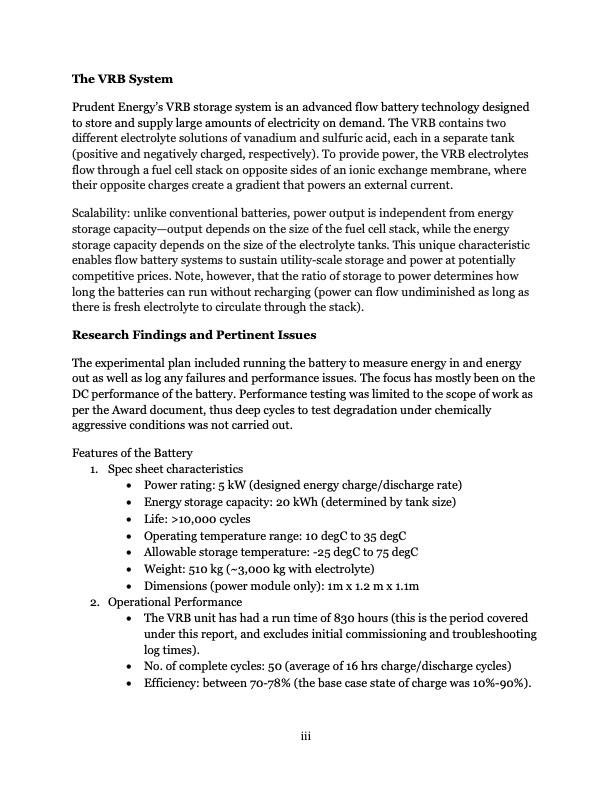
PDF Publication Title:
Text from PDF Page: 008
The VRB System Prudent Energy’s VRB storage system is an advanced flow battery technology designed to store and supply large amounts of electricity on demand. The VRB contains two different electrolyte solutions of vanadium and sulfuric acid, each in a separate tank (positive and negatively charged, respectively). To provide power, the VRB electrolytes flow through a fuel cell stack on opposite sides of an ionic exchange membrane, where their opposite charges create a gradient that powers an external current. Scalability: unlike conventional batteries, power output is independent from energy storage capacity—output depends on the size of the fuel cell stack, while the energy storage capacity depends on the size of the electrolyte tanks. This unique characteristic enables flow battery systems to sustain utility-scale storage and power at potentially competitive prices. Note, however, that the ratio of storage to power determines how long the batteries can run without recharging (power can flow undiminished as long as there is fresh electrolyte to circulate through the stack). Research Findings and Pertinent Issues The experimental plan included running the battery to measure energy in and energy out as well as log any failures and performance issues. The focus has mostly been on the DC performance of the battery. Performance testing was limited to the scope of work as per the Award document, thus deep cycles to test degradation under chemically aggressive conditions was not carried out. Features of the Battery 1. Spec sheet characteristics • Power rating: 5 kW (designed energy charge/discharge rate) • Energy storage capacity: 20 kWh (determined by tank size) • Life: >10,000 cycles • Operating temperature range: 10 degC to 35 degC • Allowable storage temperature: -25 degC to 75 degC • Weight: 510 kg (~3,000 kg with electrolyte) • Dimensions (power module only): 1m x 1.2 m x 1.1m 2. Operational Performance • The VRB unit has had a run time of 830 hours (this is the period covered under this report, and excludes initial commissioning and troubleshooting log times). • No. of complete cycles: 50 (average of 16 hrs charge/discharge cycles) • Efficiency: between 70-78% (the base case state of charge was 10%-90%). iiiPDF Image | Advanced Battery Storage Systems Testing at ACEP VRB ESS

PDF Search Title:
Advanced Battery Storage Systems Testing at ACEP VRB ESSOriginal File Name Searched:
ACEP-VRB-Testing-Report.pdfDIY PDF Search: Google It | Yahoo | Bing
Salgenx Redox Flow Battery Technology: Salt water flow battery technology with low cost and great energy density that can be used for power storage and thermal storage. Let us de-risk your production using our license. Our aqueous flow battery is less cost than Tesla Megapack and available faster. Redox flow battery. No membrane needed like with Vanadium, or Bromine. Salgenx flow battery
| CONTACT TEL: 608-238-6001 Email: greg@salgenx.com | RSS | AMP |